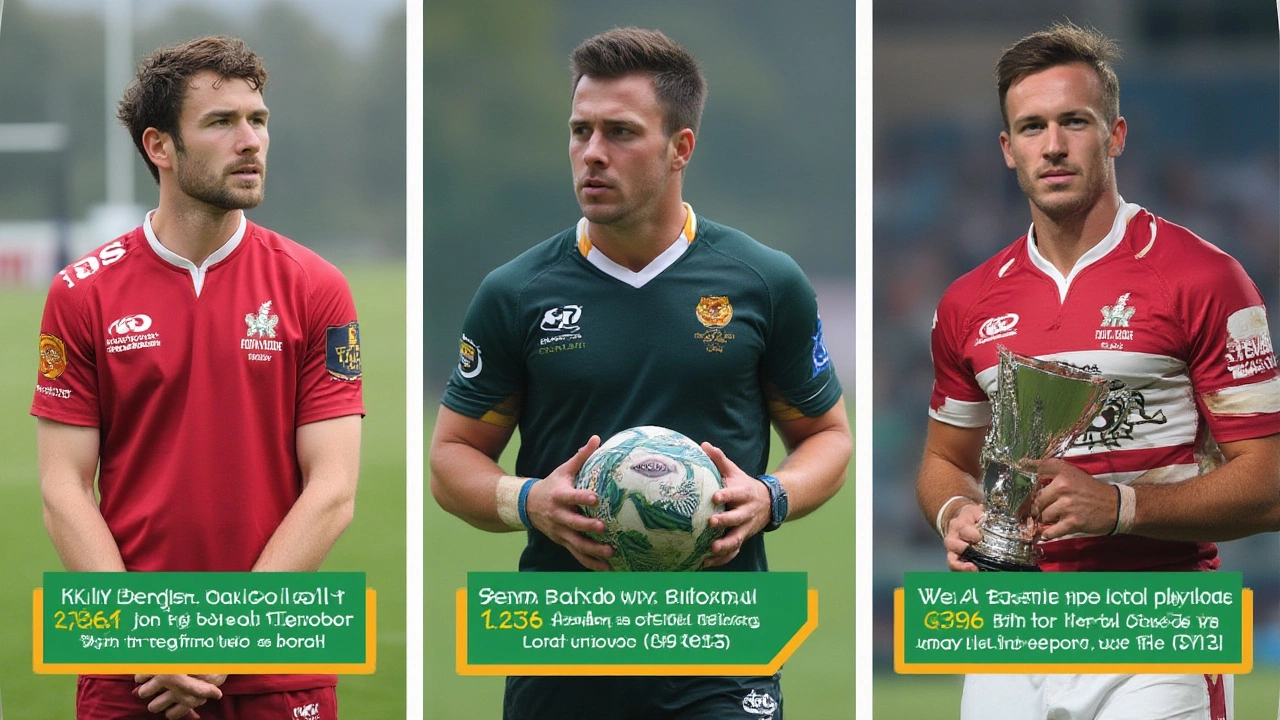Rugby Player Salaries: How Much Do Pro Rugby Players Earn in 2025?

If you think all rugby players are rolling in cash, think again. Some are making more from TikTok than from test matches. Others, sure, live the A-list sports life, driving German cars with contracts that would make any accountant smile. So, what’s the actual paycheck for someone who loves getting muddy, risking missing teeth, and chasing a funny-shaped ball?
What Influences Rugby Player Salaries?
Pocketing a pro contract depends on way more than just skills. The most obvious factor: where you play. England, France, Japan, and New Zealand have massive differences in club budgets and how players are valued. In England’s Gallagher Premiership, the average salary in 2025 hovers around £150,000 a year, but the very top players see seven-figure sums. In France’s Top 14, big signings—like Antoine Dupont—can hit €1 million per season with everything tossed in (that’s salary, image rights, bonuses, the lot). Japanese clubs sometimes rewrite the rules, signing international stars for over $1 million per season, especially late-career legends after World Cup heroics.
Position totally matters, too. Fly-halves, scrum-halves, and marquee backs stack up higher pay, basically because they’re more marketable or score headline-grabbing points. Props and hookers, who never get the Instagram love, usually see the lowest main squad earnings. Also, homegrown talent rules. Teams can often only afford megabucks for one or two “marquee” overseas players due to salary caps, so standout locals usually snag better deals. If you’re famous, brands throw money at you. Think Charles Piutau’s move to Bristol or Cheslin Kolbe shattering records with his Toulon contract—a combo of talent, timing, and global buzz sent their offers into the stratosphere.
Salary Breakdown: From Grassroots to Global Stars
The rugby pay pyramid is steep. Club academies in Europe typically pay less than minimum wage, with players scraping by—usually under £10,000 per year while juggling training and study. Break into the first squad on a development contract and you might score £20,000–£30,000. Middle-tier pros with a couple of seasons under their belts can expect £50,000–£100,000. Hardly peanuts, but not glamorous compared to soccer, F1, or even golf. Rep players (those with international caps) and homegrown icons start fetching above £200,000, and real superstars—world champs, British & Irish Lions, All Blacks—surpass £600,000, not including endorsements and image rights.
| Level | Typical Salary (GBP) |
|---|---|
| Academy/Development | £5,000–£15,000 |
| Entry First Team | £20,000–£35,000 |
| Main Squad | £50,000–£120,000 |
| Top Internationals | £250,000–£600,000 |
| Global Superstars | £700,000–£1,200,000+ |
Switch to France and those numbers spike. Average Top 14 salaries are higher, with many main squad players earning €200,000, and some outside backs, forwards, or international “names” eclipsing €1 million with commercial deals tossed in. But take a trip to the Southern Hemisphere and reality bites. In New Zealand, the regular All Black, Super Rugby, or National Provincial Championship player often takes home NZD $100,000–$300,000. A big difference, right? Even top Springboks or Wallabies can lag behind European wages, so you’ll find bold names (like Cheslin Kolbe) jumping to France or Japan for a bigger payday before hanging up their boots.

Rugby’s Salary Myths vs. Reality
Outside of a few household names, most professional rugby players aren’t getting rich. Even at the high-end, salaries pale compared to soccer’s Premier League or NBA MVPs. A salary cap exists in England and France, designed to keep the league “fair” and competitive. Clubs face strict annual wage limitations—£5 million in England (excluding a couple of marquee players who can be paid above cap), and about €10–12 million for Top 14’s overall wage bill. So no mega superteam like in football.
What happens when injuries strike? Rugby is brutal. Chronic injuries or concussions can violate even the most promising contract. Clubs do cover basic insurances, but the sport is shifting toward more performance-based bonuses than “guaranteed” years. Players may lose their deal overnight if they take a nasty knock. Many club players in Pro D2 (France’s second-tier league) or English Championship supplement pay coaching, working part-time gigs, or opening gyms and coffee shops on the side. Not exactly Netflix-doc fame and fortune.
Then there’s the women’s game. Top Black Ferns, Red Roses, and Wallaroos are starting to see pro contracts. In the UK, leading England players broke barriers by hitting £30,000–£50,000 per season contracts, with match bonuses and club income on top. In France and New Zealand, deals are creeping up, but the big dollars aren’t there yet. In women’s rugby, most still juggle full-time jobs or uni. The guys at the top might headline the news, but the average pro player is a long way off the mega-rich list.
Bonus Pay, Perks, and Sponsorships
Bonuses make things interesting. Championship wins, knock-out stage appearances, and test match victories pay out big for squads. For instance, England’s Rugby Football Union has been known to offer £25,000 to each player for a single test win, and the 2019 Rugby World Cup-winning Springboks reportedly split over $2 million in collective bonuses.
Endorsements can actually outweigh salaries for superstars. Dan Carter’s Gillette and Adidas deals, or Maro Itoje’s regular ad work, boost bank balances far beyond what most see from match pay. Companies sponsor boots, equipment, protein bars, and even cars—one Top 14 club’s “car park” is basically a dealership showcase. But for most, perks are simple: free kit, club-provided nutrition plans, gym memberships, and physiotherapy.
- Test match stacks: International appearances can pay £15,000–£30,000 per cap for tier-one nations.
- World Cup magic: In 2023, South Africa’s total bonus pool topped $2.8 million.
- Boot deals: Players at the top score up to £50,000/year from boot makers (plus unlimited pairs).
- Local endorsements: Regionals stars sometimes become the face of gyms, supplement brands, or cars.
- Social media: A huge Instagram or TikTok following can reel in fresh side money (some up to £5,000/post for ones with a genuine following).
A fun tip if you’re in the pipeline: invest your World Cup bonus sensibly. Some players I know have started small businesses, while others dumped it all in classic muscle cars. Not every contract is a lifetime ticket, so most rugby pros are quietly obsessed with planning for the future. (Liam, my spouse, has this wild dream of buying a sheep farm after “retirement”—honestly, not the worst idea considering rugby pensions aren’t nearly as generous as British MPs’.)

Tips for Aspiring Rugby Pros (and Fans)
If you’re a teenage dreamer hoping for a pro contract, remember: rugby rewards talent, heart, and timing. Get scouting attention early, but don’t forget your backup plan. Most academies now require young players to have an education or job placement path, since even the best can be cut after injury. If you make the main squad, living sensibly matters. The flashy car might look tempting, but rental deposits, insurance, and real-life costs eat up rookie wages. Smart pros get a financial advisor (ideally before the first big payday), keep side gigs open, and network endlessly for post-career jobs. Rugby can be wildly fun and rewarding, but any player will tell you, it’s a short ride with no guarantee. The best earning years? Between 25 and 32—make them count.
Insider tip for fans: if you’re desperate for a signed shirt at a match, do your homework beforehand. Lower-league and younger players are way more generous with autographs (and typically thrilled to chat), while superstars get rushed through security like pop idols. Attend sponsor events or open training days for a better shot at scoring rare merch or even a selfie. It’s all about timing and kindness—word spreads fast in rugby circles, so make your ask genuine, maybe drop a compliment about a specific play or match save. You never know, you might end up with a prized jersey—or at least a story to tell your mates over the next pint.
The world of rugby salaries isn’t all glitz and Instagram sponsorship. For every player cruising to training in the latest Range Rover, there are dozens quietly grinding, planning for their future, and playing for pure passion as much as a paycheck. Next time you’re at a match, remember the wild pay gaps behind those jerseys—and just maybe, give a little extra cheer for the grit it takes to make it in rugby today.
